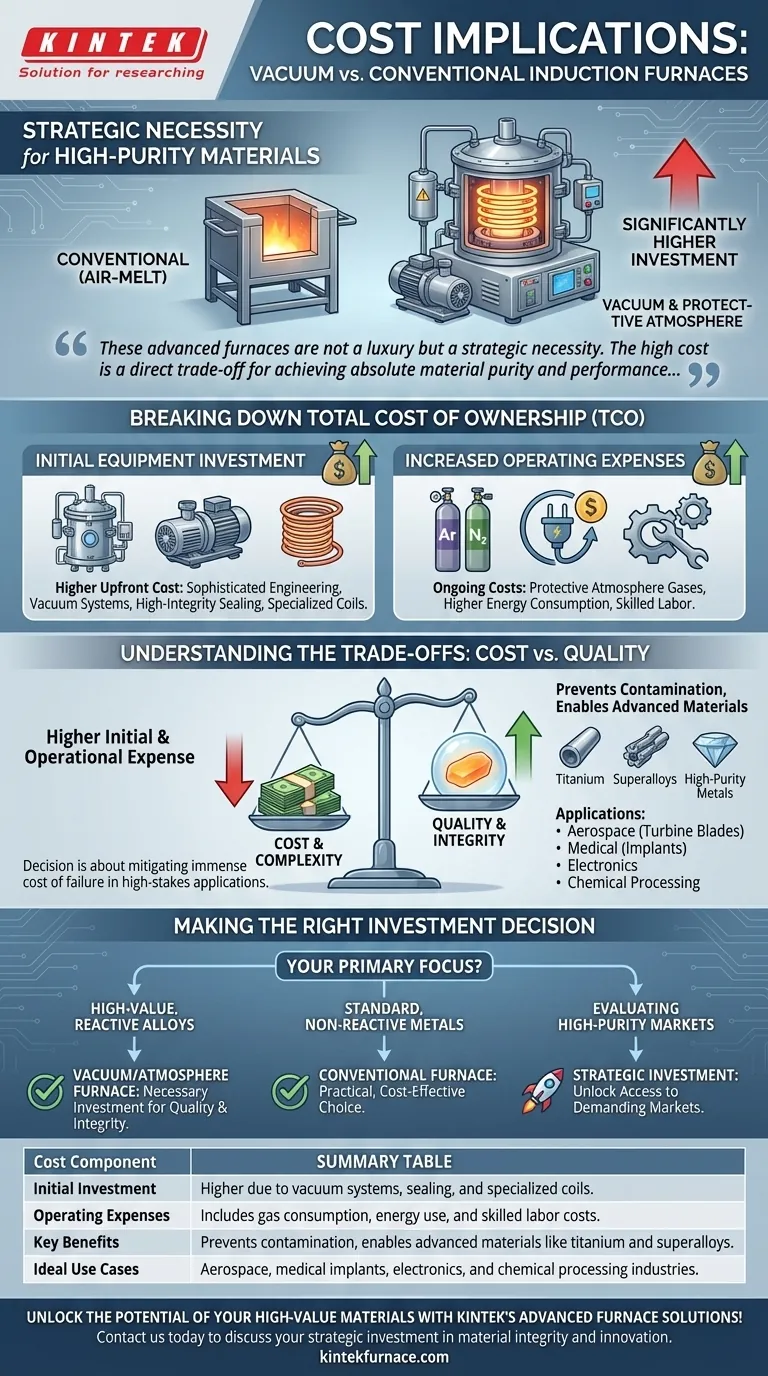The financial investment for a vacuum or protective atmosphere induction furnace is significantly higher than for a conventional air-melt furnace. This elevated cost is not limited to the initial equipment purchase; it extends to ongoing operational expenses, including higher energy use, consumable gases, and specialized maintenance.
These advanced furnaces are not a luxury but a strategic necessity. The high cost is a direct trade-off for achieving absolute material purity and performance, which is non-negotiable for critical components in industries like aerospace and medicine.
Breaking Down the Total Cost of Ownership
The cost implications are best understood by looking at both the initial capital expenditure and the long-term operational costs. These furnaces are fundamentally more complex systems.
Higher Initial Equipment Investment
The upfront cost is driven by the sophisticated engineering required. The system must be a sealed vessel capable of holding a deep vacuum or a precisely controlled atmosphere, which adds significant complexity compared to an open-air furnace.
Key cost drivers include the vacuum pumping system, the high-integrity vessel sealing, and the specialized design of the internal induction coils and their insulation to operate in these environments.
Increased Operating Expenses
Day-to-day operation is also more expensive. These costs accumulate over the lifetime of the equipment.
First, there are the direct costs of the protective atmosphere gases, such as argon or nitrogen, which are consumed during each melt cycle.
Second, the energy consumption is typically higher. Power is needed not only for melting the metal but also for running the vacuum pumps and control systems that maintain the required atmospheric conditions.
Finally, the operational complexity demands more highly skilled labor for operation and maintenance, adding to long-term personnel costs.
Understanding the Trade-offs: Cost vs. Quality
The decision to invest in this technology is never about finding the cheapest melting solution. It's about mitigating the immense cost of failure in high-stakes applications.
The Cost of Unseen Contamination
For many advanced materials, exposure to oxygen or nitrogen at high temperatures is catastrophic. It introduces impurities and oxides that degrade the material's mechanical properties, leading to brittleness or premature failure.
A vacuum or protective atmosphere furnace is the only way to prevent this contamination, effectively acting as an insurance policy against producing defective, low-quality material.
Enabling Advanced Material Production
These furnaces are not just better; they are often the only option. Materials like titanium, superalloys, and high-purity metals for electronics or medical implants cannot be processed in a standard furnace.
The high cost, therefore, represents the price of entry into markets that produce critical components like turbine blades, biomedical implants, and high-purity metals for the electronics and chemical processing industries. The value of these end products justifies the investment.
Making the Right Investment Decision
Your choice should be dictated entirely by the material requirements and the acceptable level of risk for your final product.
- If your primary focus is producing high-value, reactive, or specialty alloys: The high cost of a vacuum or protective atmosphere furnace is a necessary and justified investment to ensure product quality and integrity.
- If your primary focus is melting standard, non-reactive metals: A conventional induction furnace remains the more practical and cost-effective choice, as the added expense for atmospheric control offers no significant benefit.
- If you are evaluating a move into high-purity applications: View the furnace cost not as an expense, but as a strategic investment in capability that unlocks access to more demanding and profitable markets.
Ultimately, the decision hinges not on the furnace's price, but on the value and required integrity of the materials you intend to produce.
Summary Table:
| Cost Component | Details |
|---|---|
| Initial Investment | Higher due to vacuum systems, sealing, and specialized coils. |
| Operating Expenses | Includes gas consumption, energy use, and skilled labor costs. |
| Key Benefits | Prevents contamination, enables advanced materials like titanium and superalloys. |
| Ideal Use Cases | Aerospace, medical implants, electronics, and chemical processing industries. |
Unlock the potential of your high-value materials with KINTEK's advanced furnace solutions! Leveraging exceptional R&D and in-house manufacturing, we provide diverse laboratories with tailored high-temperature furnace systems, including Vacuum & Atmosphere Furnaces, Muffle, Tube, Rotary Furnaces, and CVD/PECVD Systems. Our strong deep customization capability ensures precise alignment with your unique experimental needs, enhancing purity and performance for critical applications in aerospace, medicine, and beyond. Contact us today to discuss how we can support your strategic investment in material integrity and innovation!
Visual Guide

Related Products
- Vacuum Induction Melting Furnace and Arc Melting Furnace
- 1700℃ Controlled Inert Nitrogen Atmosphere Furnace
- 1200℃ Controlled Inert Nitrogen Atmosphere Furnace
- 1400℃ Controlled Inert Nitrogen Atmosphere Furnace
- Mesh Belt Controlled Atmosphere Furnace Inert Nitrogen Atmosphere Furnace
People Also Ask
- What components make up a Vacuum Induction Melting Furnace? Discover the Key Systems for Pure Metal Melting
- What are the key features and benefits of a Vacuum Induction Melting Furnace? Achieve High-Purity Metal Production
- What industries benefit from Vacuum Induction Melting Furnaces? Unlock High-Purity Metals for Aerospace, Medical, and More
- What are the advantages of vacuum induction melting? Achieve Superior Purity for High-Performance Alloys
- What are the main applications of vacuum induction melting (VIM) furnaces? Achieve Unmatched Metal Purity for Critical Industries



















